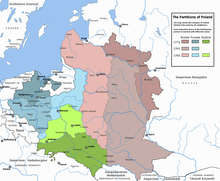Events

| Years in Russia: | 1790 1791 1792 1793 1794 1795 1796 |
| Centuries: | 17th century · 18th century · 19th century |
| Decades: | 1760s 1770s 1780s 1790s 1800s 1810s 1820s |
| Years: | 1790 1791 1792 1793 1794 1795 1796 |


Minsk is the capital and the largest city of Belarus, located on the Svislach and the now subterranean Niamiha rivers. As the capital, Minsk has a special administrative status in Belarus and is the administrative centre of Minsk Region and Minsk District. As of 2023, it has a population of two million, making Minsk the 11th-most populous city in Europe. Minsk is one of the administrative capitals of the Commonwealth of Independent States (CIS) and the Eurasian Economic Union (EAEU).

Prince Friedrich Karl Nikolaus of Prussia was the son of Prince Charles of Prussia (1801–1883) and his wife, Princess Marie of Saxe-Weimar-Eisenach (1808–1877). Prince Friedrich Karl was a grandson of King Frederick William III of Prussia and a nephew of Frederick William IV and William I.

The House of Dadiani, later known as the House of Dadiani-Chikovani, was a Georgian family of nobles, dukes and princes, and a ruling dynasty of the western Georgian province of Mingrelia.

The House of Sapieha is a Polish-Lithuanian noble and magnate family of Lithuanian and Ruthenian origin, descending from the medieval boyars of Smolensk and Polotsk. The family acquired great influence and wealth in the Polish–Lithuanian Commonwealth during the 16th century.

The Minsk Governorate or Government of Minsk was a governorate of the Russian Empire. The seat was in Minsk. It was created in 1793 from the land acquired in the partitions of Poland and lasted until 1921.

Karl Anton, Prince of Hohenzollern-Sigmaringen was the last prince of Hohenzollern-Sigmaringen before the territory was annexed by the Kingdom of Prussia in 1849. Afterwards he continued to be titular prince of his house and, with the death of the last prince of Hohenzollern-Hechingen in 1869, of the entire House of Hohenzollern. He served as Minister President of Prussia from 1858 to 1862, the only Hohenzollern prince to hold the post. His second son, Karl, became king of Romania. The offer of the throne of Spain to his eldest son, Leopold, was one of the causes of the Franco-Prussian War, which led to the unification of Germany and the creation of the German Empire.

The Courland Governorate, also known as the Province of Courland, Governorate of Kurland and known from 1795 to 1796 as the Viceroyalty of Courland was one of the Baltic governorates of the Russian Empire, that is now part of the Republic of Latvia.

The Order of Saint Stephen was an order of chivalry founded in 1764 by Maria Theresa. In 1938, Miklós Horthy took the rights and activities of Grand Master as Regent of Hungary. The name of the Order changed to the Royal Hungarian Order of Saint Stephen. The Order was terminated at the time of the proclamation of the Second Hungarian Republic in 1946. It was recreated in 2011 as the Hungarian Order of Saint Stephen, and to this day remains the highest order in Hungary.

The Russian Partition, sometimes called Russian Poland, constituted the former territories of the Polish–Lithuanian Commonwealth that were annexed by the Russian Empire in the course of late-18th-century Partitions of Poland. The Russian acquisition encompassed the largest share of Poland's population, living on 463,200 km2 of land constituting the eastern and central territory of the former commonwealth. The three partitions, which took place in 1772, 1793 and 1795, resulted in the complete loss of Poland's sovereignty, with its territory split between Russia, Prussia and Austria. The Napoleonic Wars saw significant parts of Prussia's and Austria's partitions reconstituted as the Duchy of Warsaw, most of which was then reconstituted as the Kingdom of Poland within the Russian Empire in 1815.

Belposhta or Belpochta is the national postal service of Belarus. It became a member of the Universal Postal Union in 1947.

William Higgin was the 18th Bishop of Limerick, Ardfert and Aghadoe from 1849 until 1853, when he was translated to Derry and Raphoe.


The Diocese of Minsk is an eparchy of the Belarusian Orthodox Church, which is an exarchate of the Russian Orthodox Church.

Apolinary Horawski, also seen as Gorawski was a Belarusian-born Polish painter active mainly in St. Petersburg.
Borisovsky Uyezd was one of the uyezds of Minsk Governorate and the Governorate-General of Minsk of the Russian Empire and then of Byelorussian Soviet Socialist Republic with its seat in Borisov from 1793 until its formal abolition in 1924 by Soviet authorities.
Igumensky Uyezd was one of the uyezds of Minsk Governorate and the Governorate-General of Minsk of the Russian Empire and then of Byelorussian Soviet Socialist Republic with its seat in Igumen from 1793 until its formal abolition in 1924 by Soviet authorities.
Minsky Uyezd was one of the uyezds of Minsk Governorate and the Governorate-General of Minsk of the Russian Empire and then of Byelorussian Soviet Socialist Republic with its seat in Minsk from 1793 until its formal abolition in 1924 by Soviet authorities.
Rechitsky Uyezd was one of the Uyezds of Minsk Governorate and the Governorate-General of Minsk of the Russian Empire and then of Byelorussian Soviet Socialist Republic with its center in Rechytsa from 1793 until its formal abolition in 1924 by Soviet authorities.
Slutsky Uyezd was one of the uyezds of Minsk Governorate and the Governorate-General of Minsk of the Russian Empire and then of Byelorussian Soviet Socialist Republic with its center in Slutsk from 1793 until its formal abolition in 1924 by Soviet authorities.
![]() Media related to 1793 in Russia at Wikimedia Commons
Media related to 1793 in Russia at Wikimedia Commons